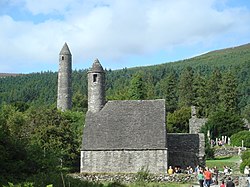Glendalough
| Gleann Dá Loch | |
 |
|
| Monastery information | |
|---|---|
| Order | Celtic Christianity |
| Established | 6th century |
| Disestablished | 1398 |
| Diocese |
Glendalough (to 1185) Dublin and Glendalough (1185–1398) |
| People | |
| Founder(s) | Saint Kevin |
| Architecture | |
| Status | Inactive |
| Style | Irish monastic, Romanesque |
| Site | |
| Location | County Wicklow |
| Coordinates | 53°00′37″N 6°19′39″W / 53.01028°N 6.32750°WCoordinates: 53°00′37″N 6°19′39″W / 53.01028°N 6.32750°W |
| Visible remains | Round tower, gateway, cathedral, several churches |
| Public access | yes |
| Website | www |
Glendalough (/ˌɡlɛndəˈlɒx/; Irish: Gleann Dá Loch, meaning "Valley of two lakes") is a glacial valley in County Wicklow, Ireland, renowned for an Early Medieval monastic settlement founded in the 6th century by St Kevin.
Kevin, a descendant of one of the ruling families in Leinster, studied as a boy under the care of three holy men, Eoghan, Lochan, and Eanna. During this time, he went to Glendalough. He was to return later, with a small group of monks to found a monastery where the 'two rivers form a confluence'. Kevin's writings discuss his fighting "knights" at Glendalough; scholars today believe this refers to his process of self-examination and his personal temptations. His fame as a holy man spread and he attracted numerous followers. He died in about 618. For six centuries afterwards, Glendalough flourished and the Irish Annals contain references to the deaths of abbots and raids on the settlement.
Around 1042, oak timber from Glendalough was used to build the second longest (30 m) Viking longship ever recorded. A modern replica of that ship was built in 2004 and is currently located in Roskilde, Denmark.
...
Wikipedia

